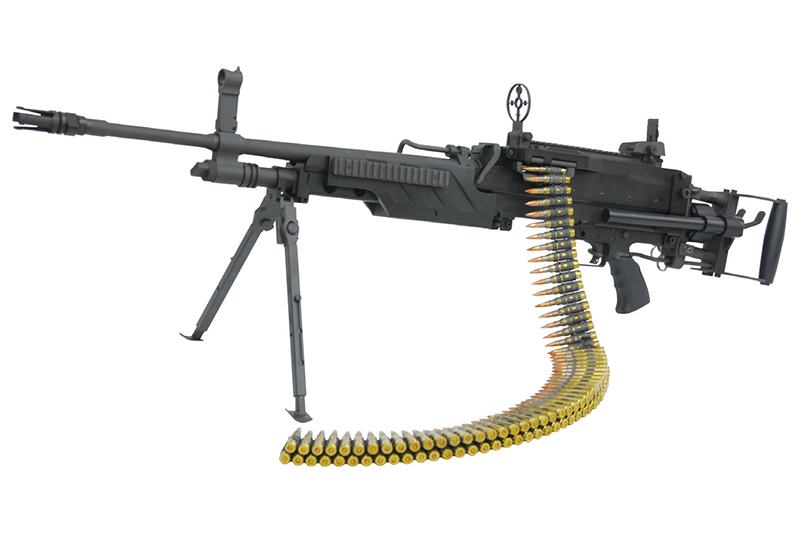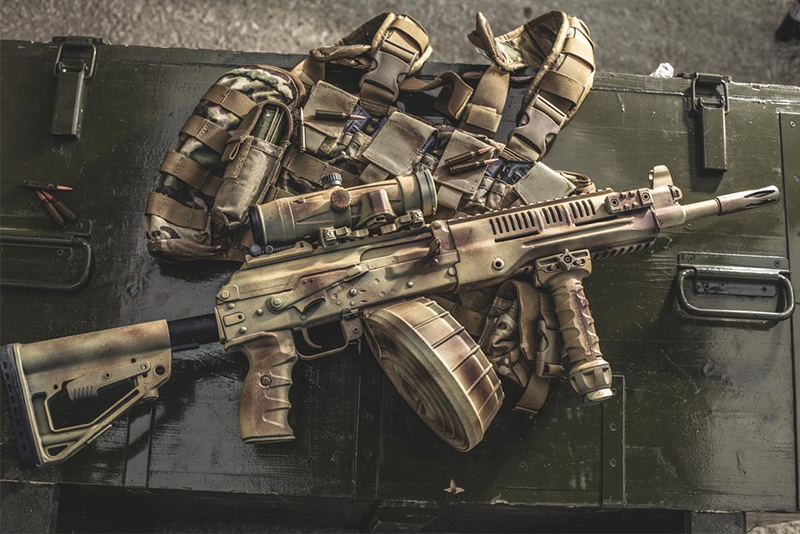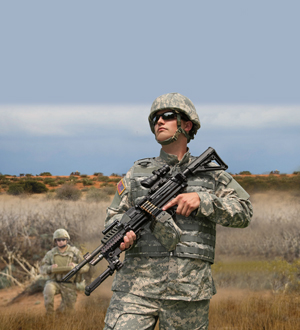
A review of some of the latest firepower becoming available to riflemen and those firing automatic weapons in today’s infantry.
Weapons of the combat infantry small unit must address tasks ranging from suppression of enemy in dug-in positions by automatic riflemen and machine gunners to the dedicated marksman’s precise engagement of individual targets and the arms of each rifleman. Developments in small arms and recent initiatives by a number of the world’s militaries suggest it is timely to examine the direction of each of these classes of squad and platoon arms.
Rifles and machine guns
The heart of the dismounted ground defence has been and continues to be the machine gun and automatic rifle.
The former are given priority in being positioned to provide flanking an enfilade fires covering the most likely avenues of attack by the enemy. The later then are placed to cover secondary approaches and to protect the machine guns. Similarly the machine gun is critical to the friendly attack. Here it provides the base of fire which will keep the defenders ‘heads-down’ reducing their ability to effectively engage the attack.
Rifleman with automatic weapons moving with the attack force supplements these suppressive fires. They will also take up the machine gunners task when they must shift their fires so as friendlies sweep over the objective.
Given the need to place sustained fires on either an enemy defensive positions or on their attacking assault these weapons need to reliably deliver continuous fires without stoppage or failure. The challenge has been how to assure this while also reducing the carry weight of the weapon to make it more manageable.
In fact, there is considerable debate regarding the most appropriate automatic weapon for the squad. The question is whether this should be an automatic rifle (AR) as represented by the renowned Browning Automatic Rifle (BAR), the light machinegun (LMG) such as the FN Minimi/M249, or a medium or general purpose machine gun (GPMG) like the Russian PK. The challenge is in achieving the characteristics seen desirable for a weapon to be used within the constraints of the front line small infantry unit.
GPMGs
The GPMG have proved to reliably provide well aimed sustained fires, although their weight discourages its adoption by the small unit. However, industry initiatives have sought to overcome this.
PK Machinegun
Russian infantry still employ the PKM or Modernizirovanniy Pulemyot Kalashnikova (PK Machinegun Modernised) first introduced in the 1960s. It is also widely exported and produced under license gaining particular mention by US soldiers in Afghanistan on its ability to engage at ranges of up to 1000m. This is further facilitated by its use of a 1P29 optical sight. The PK is readily fit to a tripod mount which enhances its accuracy over the bipod. Using an operating mechanism similar to the AK, at 16.53lb (7.5kg) with bipod and using 7.62x54R ammunition it is not particularly light but has proved to be reliable even in the extreme conditions. This is reflected in its fielding by over eight-five armies.
M240
The FN MAG58 designated M240 by the US, is another widely used GPMG. It has also been the subject of a number of improvement efforts. One by Barrett Firearms Manufacturing has resulted in the M240LW (Lightweight). Bill Geissele, president of Geissele Automatics, who has technical rights, explained: “The 7.62mm 240LW/LWS is improved in every performance aspect: it is lighter, more reliable, easier to load, easier to maintain, more ergonomic and more controllable making it a machine gun for the 21st century.” The new M240LW is lighter at weighs 21lbs (9.55kg) and shorter at 44in (112cm).
The issue with the GPMG at squad level is that it was designed as a crew served weapon which even at reduced weight remains requires a trade-off in personnel that may not be acceptable with a squad size of eight or less.
LMGs
The light machine gun traces it origin to the Great War and the German introduction of Stormtrooper tactics. These small units required a fast firing but light weapon they could carry with the assault force.
The ability of today’s LMG to achieve the desired portability has been significantly enhanced by the introduction of smaller calibre ammunition such as the 5.56x45mm NATO and the Russian 5.45×39. Their lower recoil permits lighter weapon designs while smaller cartridge size allows for carrying more rounds. The trade-off is reduced lethality and accuracy at longer ranges.
Minimi
The US military in 1984 fielded the M249, an adaption of the FN Minimi which is used over 50 countries. Minimi is widely used by Asian-Pacific armies with the weapon licence manufactured by Sumitomo Heavy Industries for the Japanese Self Defence Forces, by Thales Australia as the F89 for the Australian Army and as the Pindad SM-3 in Indonesia. In addition, the Republic of China (Taiwan) uses a local design, the T75 Light machine gun produced by the 205th Armoury which is based on the FN weapon.
Mk3 version
An FN Herstal spokesperson explained that its latest Mk3 version “offers improvements based on operational experience and user feedback over the past 10–15 years.” New features include the ability to convert to either 5.56×45mm or 7.62×51mm rounds, a five position adjustable stock, picatinny rails, and a three position adjustable bipod. The Mk3 features can be incorporated into existing weapons as an upgrade.
K3 LMG
Taking a similar path the Republic of Korea’s Agency for Defence Development designed its 5.56mm K3 LMG manufactured by S&T Motiv (Daewoo Precision Industries) to replace the M60 machine gun. Fielded in 1989 it is substantially lighter at 15.10lb (6.68kg) with the flexibility of feeding from a 30 round magazine and 200-round disintegrating M27 belt. It too has an integrated bipod but also fits to a tripod for more accurate firing. The largest user outside Korea is the Philippine Army which acquired 6,540 units in 2008 although it is also used by Indonesia’s the Komando Pasukan special forces. The company introduced it Para version in 2015 which at 31.7in (805mm) is shorter when collapsed and lighter at 13.89lb (6.3kg).
K12
A new machine gun, the K12, is being developed which draws on the K3 design it is, however, 7.62mm. This calibre is being is driven by the Army’s need to replace its ageing M60 GPMG inventory used on vehicles and helicopters as well as the desire to have return to the longer range and power of the 7.62 in at least some infantry roles. Currently at 26.4lbs (12kg) it falls outside the LMG category but it does have a unique feature in that it incorporates not only a pistol grip but also a rear spade grip and metal sliding stock in each weapon. This allows the same design to be used in a variety of mountings. The Indian Army reported visited S&T Motiv in May 2019 and may be considering the K12 as a candidate for its next machinegun.

Ultimax 100
Singapore’s ST-Engineering has made improvements to its Ultimax 100 in the new Mark 8 model. Already known for having the lightest recoil and exceptional accuracy in a 5.56mm calibre machine gun due to its patented constant recoil feature the Mk 8 adds both automatic and semi-automatic fire modes, as well as a quick-change barrel. At 11lbs (5kg) it is easily operated by a single soldier.
An ST-Engineering spokesperson shared that: “Ultimax’s features like its removable and retractable stock with height adjustments, inclusion of picatinny rails and ability to use M16 type box magazines, 100 rounds C-MAG and ULTIMAX 100 drum magazines offer flexibility in a variety of roles” Ultimax is used by 25 countries.
RPK-16
The Russian military is also considering a new squad machine gun the RPK-16. First shown in 2017, it a new iteration of the iconic Kalashnikov light machine gun using the same 5.45×39 cartridge as the AK-74. It has an interchangeable barrel with both a full-length and a short barrel offered. Its stock not only folds but is telescoping and can be adjusted. The bipod is detachable bipod; it has rails for scopes and other equipment, and can be fit with a suppressor. The gun has a 96 round high capacity magazine but can also use any existing AK-style magazines. The bipod is no longer an integral part of the machine gun and it can be attached and detached freely. The weapon according to Kalashnikov is undergoing field tests but it may have been fielded in limited numbers to Spetnaz.

Common Squad Weapons
The Peoples Republic of China (PRC) had largely employed either the Type 67or Type 80 GPMG, either locally designed or adapted and using 7.62x54R ammunition.
QBZ-95 Infantry Weapons Family
However, in 1997 the QBZ-95 Infantry Weapons Family appeared. Designed and manufactured by Norino it is a bullpup-style weapon that fires a new 5.8×42mm DBP87 cartridge. The family consists of an assault rifle, a carbine and the QBB-95 Light Support Weapon (LSW).
The LSW is intended as the squad automatic weapon variant and adds a bipod, a longer, a heavier barrel and 80-round drum magazine, though it can also use the standard 30-round box magazine. These features begin to blur the difference between the LMG and AR.
An improved version, the QBB-95-1, has since been fielded addressing several reliability and ergonomic issues as well as, firing a heavier 5.8×42mm DBP10 round. This places the PRC military in the forefront in providing a level of weapon and ammunition commonality with its advantages within the squad.

US Marine Squad Weapons
The US Marines have moved to a similar squad commonality though it might be said in their case it was ‘backed into’. Their initial push was to find an alternate to the M249 LMG for the squad automatic rifleman (AR).
Following evaluation of a number of candidates they selected the Heckler & Koch HK416 a magazine feed automatic rifle. The weapon is already adopted by the German, French, Norwegian and other forces. With the Marine’s adaption’s it was designated the M27.
It met the Marines requirement for a more accurate AR offering 2 Minute of Angle (MOA) accuracy vs. 12 of the M249 meaning a round would strike within 50mm of the point of aim at 100m. Subsequently the Marines determined to field the M27 to all members of the infantry squad, thus, providing an AR capability to every infantryman. Its further adoption of a more accurate M27 version, the M38, with better optics as the Squad Designated Marksman Rifle rounded out the Marine’s squad commonality.
US Army Next Generation Squad Weapon

Currently the US Army is seeking a Next Generation Squad Weapon which is built around a new 6.8mm cartridge intended to have better accuracy at longer ranges and to be effective against personal body armour. Three candidates have been selected and are competing.
Sig Sauer, Textron, and General Dynamics each will offer a replacement for the M249 SAW and assault rifle to substitute for the M4. Of the candidates two former employ belted ammunition as a LMG while the later is a magazine fed AR design. Army programme officials indicate they plan to select a final design from a single company in early 2022 and begin fielding in 2023.
Squad Automatic Weapon direction
The number of programmes defining a new standard for the squad automatic weapon suggests continued recognition of its key role in small unit combat. Each seeks to concurrently reduce the automatic rifleman’s load, while increasing effective range and lethality.
In addition, weapons like the M27/HK416 particularly enhance the unit’s tactical flexibility by essentially providing every squad member the ability to assume the AR role on direction. When combined with new ammunition and the introduction of more advanced optics, miniaturised range finding and ballistic computation the capabilities of these weapons is approaching that of previously found in the Company level GPMG.
This introduction holds the potential to have significant implications for the infantry combat unit, its future organisation and employment.












